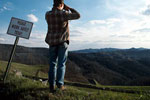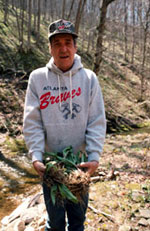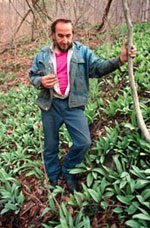Seng Talk and Ginseng Tales:
Conjuring the Commons
For seng aficionados, the ongoing prospect of ginseng makes the mountains gleam with hidden treasure. "It's like catching a big fish," said Randy Halstead. "You're out here all day and you find this big fish, and you know it's everybody's desire to catch this big fish in the lake. You find this big enormous plant and you know everybody that's out there digging, this is the one that they'd like to find. So you get an adrenalin rush when you find them, and when you find a big one it's like showing off your daily catch. You bring it in and say, 'Look what I found today.'"
"You can't get out and dig it for the money," said Joe Williams. "It's like looking for Easter eggs. You're always looking for the big one. If I found one eight ounces, I believe I'd quit."
"The one that boy brought in up at Flats weighed a pound," said Randy Sprouse.
"I'd like to have seen that one," said Williams.
"It was a monster," Sprouse emphasized.
"That's what you get out for," Williams mused. "Always looking for the big one."
On Coal River, ginseng plays a vital role in imagining and sustaining a culture of the commons. Among the means of keeping the commons alive is talk about ginseng: where to hunt it, its mysterious habits, the biggest specimens ever found, and the difficulties of wresting the treasure from an impossibly steep terrain shared by bears, copperheads, rattlesnakes, and yellow-jackets. The ability and authority to engage in this discourse is indeed hard won.
Over generations of social construction in story and in practice, places on the commons accrue a dense, historical residue. Every wrinkle rippling the mountains has been named for people, flora, fauna, practices, and events both singular and recurrent: Beech Hollow, Ma Kelly Branch, Bear Wallow, Board Camp Hollow, and Old Field Hollow. "I guess there must have been a newground in there at one time," said Ben Burnside, of Rock Creek, alluding to the old-time practice of clearing woodland to grow corn and beans.
Overlooking the valley from its giant tightly crimped rim, places like the Head of Hazy, Bolt Mountain, Kayford Mountain, the Cutting Box, Chestnut Hollow, and Sugar Camp anchor realities spun out in a conversation that Woody Boggs videotaped in Andrew, West Virginia. In one exchange, Cuba Wiley and Dave Bailey conjure and co-inhabit a terrain so steep that seng berries would roll from the ridge to the hardtop.
"You know where the most seng is I ever found up in that country?" asked Cuba Wiley. "I'm going to tell you where it was at. You won't believe it."
"Chestnut Holler, I'll bet you," guessed Dave Bailey.
"I found one of the awfullest patches of it, left-hand side of Chestnut Holler," Cuba continued. "I never seen such roots of seng in my life, buddy. And where I found all my seng, the good seng, come right this side of Clyde Montgomery's, and come down that first holler, and go up that holler and turn back to the right. Buddy it is steep."
"Going toward the Cutting Box?" asked Dave Bailey, referring to a place named for a mining structure.
"I senged that through there," said Cuba, "from there to Stickney, and I have really found the seng in there. One time me and Gar Gobel was in there, and Clyde would start up the mountain, and we just kept finding little four-leaves, all the way up the mountain.
"Gar says, 'Cuba, there's a big one somewhere. It seeded downhill.' We senged plumb to the top of the mountain, Cutting Box, got on top, and that old big nettleweed was that high, Gar had him a big stick, was hunting for the big one. Right on tip top the mountain, directly beneath them, it was about up to my belt, buddy. It didn't have such a big root on it, and I still wasn't satisfied. Gar, he dropped over the Cutting Box, and I still searched around up on top, parting the weeds, and directly, I found them about that high [indicates a height of about three feet], two of them right on top of the mountain. It was so steep, [the berries] rolled plumb down next to the hard road, buddy. I got more seng in there than any place I ever senged in that part of the country. It's steep, buddy."
"It's rough too, ain't it?" said Dave Bailey.
"It's rough, buddy," Cuba agreed. "But I swear I dug some good seng in there, buddy. And I dug some good seng in Sugar Camp."
Cuba's amazing account reminds Woody Boggs of a tall tale he heard from his brother. "You remember that time Bud and French Turner was…up there sawing timber for Earl Hunter? Remember Bud telling you about that? He said he was sawing that big tree. Thought it was a buckeye. And stuff like tomatoes started hitting him in the head."
"It was seng berries," laughed Dave.
"It was seng berries," Woody deadpanned.
"Said it was big as tomatoes," said Dave, still chuckling.
"Boy, that was some stalk of seng," allowed Cuba, his eyes twinkling.
Such stories conjure the commons as a rich social imaginary. Through narrative the commons becomes a public space, its history played out before audiences who know intimately its spaces whether they have been there together or not. Inhabiting the commons through practice and narrative confers social identity and makes a community of its occupants. "I work in construction," wrote Dennis Price, forty, of Arnett, on a petition to document the cultural value of the mixed mesophytic forest. "But really I consider myself a ginsenger."
In the realm unfolded through ginseng stories and other tales of plying the woods, the commons becomes a proving ground on which attributes of courage, loyalty, belonging, stamina, wit, foolishness, stewardship, honesty, judgement, and luck are displayed and evaluated. Collective reflection on what it means to be a ginsenger gives rise to reflection on what in fact it means to be human. It is through such a process that the geographic commons nurtures a civic commons as a forum for consensus and dissent.

![]()
![]() Randy Sprouse at the Costain Mine Reclamation site, White Oak. Lyntha Scott Eiler. 1997/04/20. Library of Congress American Folklife Center.
Randy Sprouse at the Costain Mine Reclamation site, White Oak. Lyntha Scott Eiler. 1997/04/20. Library of Congress American Folklife Center.

![]()
![]() Dave Bailey with ramps near Poplar Flats on Hazy Creek. Lyntha Scott Eiler. 1996/04/11. Library of Congress American Folklife Center.
Dave Bailey with ramps near Poplar Flats on Hazy Creek. Lyntha Scott Eiler. 1996/04/11. Library of Congress American Folklife Center.

![]()
![]() Cuba Wiley, Peytona, WV. Lyntha Scott Eiler. 1996/04/13. Library of Congress American Folklife Center.
Cuba Wiley, Peytona, WV. Lyntha Scott Eiler. 1996/04/13. Library of Congress American Folklife Center.

![]()
![]() Woody Boggs in the ramp patch that he planted on the hill behind his home. Lyntha Scott Eiler. 1996/04/11. Library of Congress American Folklife Center.
Woody Boggs in the ramp patch that he planted on the hill behind his home. Lyntha Scott Eiler. 1996/04/11. Library of Congress American Folklife Center.
